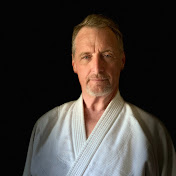Aikido Stick Training by Richard E. Killblane
As the instructor of Virginia Aikikai, I train under an aikido sensei more experienced than me – Jim Baker of Aikido of Norfolk. He has used sticks to teach us how to quit using muscle and lead our partners by synchronizing our movements with each of us holding onto the end of an eskrima stick. Eskrima is the Philippine martial art of stick fighting with a one and a half foot stick. When Covid shut down many martial arts schools because of the mask and social distancing mandates. It became obvious that this shutdown would last many months, I knew that I needed to keep my students active or they might lose interest in aikido over the long break. Fortunately, Jim informed me about an idea he had for training with sticks.
On May 9, 2020, I went to see what Jim proposed. He showed me short sticks that he had made from two different diameters of wooden dowels. He was experimenting with two sizes because various students would prefer different size grips. He painted one end red so that the partners would always hold the same end all through practice thus reducing the spread of the virus. The problem with only painting the flat end, I had to pick it up to look at which end was red. My plan was to paint a couple inches of the end of the stick instead of just the end. Wood is porous, it would require cleaning with soap and water to use with another partner, Jim was considering having the same partners practice throughout the class. I suggested painting the sticks so they were non-porous and could be wiped down with alcohol, that way we could change partners during practice. Jim also suggested that leaving the sticks in soapy water overnight would kill the virus. He then showed me how to perform different aikido techniques with the sticks. We just led our partners to the point of taking their balance and not finishing the throw since we were training outdoors.
Jim’s wife, Wendy, was a medical examiner for the area of Norfolk and added that it was safer to train outdoors because of better air circulation. Jim and I agreed that everyone had to wear masks during practice. There was no wind in their backyard because of how close the houses were but my neighborhood was so open that my backyard always had a breeze. I realized that I could invite my students to begin practicing in my backyard one-on-one as soon as I made the sticks. Since I was retired, we were not limited to which days of the week or hours that we could train. I emailed them this message upon my return home.
Most aikido dojos that remained open focused on weapons katas (a set pattern of moves) such as the 31-count jo (4-foot staff) kata. Nothing enforces social distancing better than a bokken (wooden sword) or jo. Some students preferred to just train with weapons so we developed our own paired katas. Since the movements of aikido are based upon weapons, this became another effective way to continue to improve aikido skills. Amanda Olmstead liked the idea of training with the sticks, which significantly improved our skill levels. We experimented with nearly all the aikido techniques and found a way to practice them with the sticks. While my students only got one or two days of practice a week, I benefitted more from the sum total of training days. After the mask mandate was lifted outdoors and when the Commonwealth of Virginia allowed gymnasiums and community centers to reopen, I had managed to keep all my aikido students and Amanda and I still enjoy practicing outdoors.
REK
